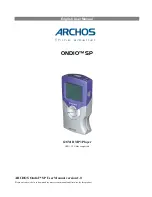
May 15, 2012 • Alcorn McBride TourTraXX User’s Manual • Rev 1.3 • Page 19
Additional Features
Microphone Paging
Using the rear microphone input of TourTraXX, you can page to any channel, channel pair, or channel
group. The channel/group of channels that TourTraXX will route the microphone to is called the
paging zone.
The paging zone can be changed with an Ethernet or serial control command, or a
command triggered by a rear input. Paging can be triggered by any input, including the push-to-talk
input on the TourTraXX’s 4-pin Molex mic input.
Because of the flexibility of TourTraXX commands, you could select your current paging zone with a
command sent from a show controller, a local button box connected to the rear inputs configured as
contact closure, a PLC triggering the rear inputs via voltage input, or, depending on the complexity of
your application, all three. This technique can be used to allow the person doing the paging to choose
exactly where their page will be routed.
Paging is started and stopped with a control command or you can choose a
paging trigger
. The paging
trigger is a front panel button, rear input, or mic push-to-talk input that initiates paging while active and
returns channels to their previous source when released.
While paging over a channel currently playing an MP3, the MP3 will be paused. Once paging
concludes, it will resume from the exact point it was at when paging started.
For a complete listing of available paging commands, see the
Command Protocol
section of this
manual.
Note: Paging zones and triggers cannot be changed while currently paging.
Line Input
TourTraXX includes an auxiliary stereo line input on a 4-pin Molex type connector located on the rear
of the unit. You can use this input to connect any external audio source (such as a phone, mixer,
computer, etc.) Like microphone paging, this input can be routed to any channel or group of channels
with a standard TourTraXX command from Ethernet, Serial, or any rear input or front panel button.
Unlike microphone paging, the Line Input does not activate on a special “trigger”, but is started and
stopped with control commands, much like an MP3 file. For the complete command format, see the
Command Protocol
section of this manual.
















































